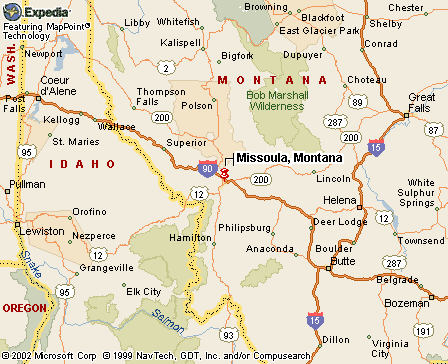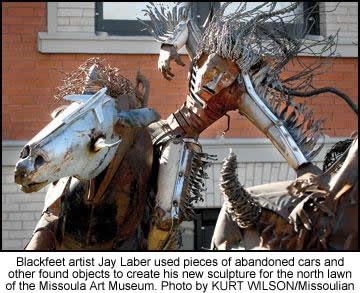 |
Canku Ota
|
 |
|
(Many Paths)
|
||
|
An Online Newsletter
Celebrating Native America
|
||
|
December 1, 2008 - Volume
6 Number 3
|
||
|
|
||
|
from junked cars
to expressive art -
Blackfeet sculptor’s work on display at Missoula Art Museum |
||
|
by Jodi Rave of the
the Missoulian
|
||
|
credits: Photo by KURT
WILSON/Missoulian
|
|
Now any visitor to the Missoula Art Museum can look closely at Laber’s work outside on the north side of the building - and see the texture of the buffalo’s tongue. He wasn’t always that committed to detail. Laber, a Blackfeet artist who lives on the Flathead Reservation, used to look at a junked, rusted car and imagine the infinite possibilities - wild hair swirling above the head of a dancing warrior, a horse running on an open plain, an eagle soaring above the antlers of a bugling elk. He has succeeded in capturing time and sealing the moment in steel. The MAM is displaying Laber’s work as part of its “Elk Dogs” exhibit, which continues through Feb. 21. It’s being displayed in the Lynda M. Frost Contemporary American Indian Gallery. A gallery talk and artist reception is scheduled on Dec. 5. The “Elk Dogs” installation features four invited artists, including Laber, Damian Charette, David Dragonfly and Jeneese Hilton. Additional “elk dog” art was chosen from the museum’s contemporary Indian art collection. In many indigenous languages, the name elk dog is the historical translation for the horse, an animal brought to the North American continent by the Spaniards. The Natives described the horse as an animal as big as an elk and saw an animal that could be used to pack goods like a dog. The MAM exhibit is a tribute to horses, seen through the eyes of Natives. Some of the first metal horses Laber created were designed to be seen from a distance, like a mile away. “I purposely didn’t want people to know it was made from junk,” he said. So, he didn’t care much if his warrior had eyebrows. But now that his sculptures are being purchased for upward of $10,000, he finds his art being displayed up close and in easily accessible places, like on the front lawn of a museum in downtown Missoula. So, he’s careful to take his time and shape tubes of metal into a finely detailed necklace. What hasn’t changed is his penchant for automobile parts, barbed wire and farm machinery. He credits Corky Clairmont, an art instructor at Salish Kootenai College in Pablo, for inspiring him to use what was in his immediate environment. “I’m from Browning,” said Laber. “I think he thought I was going to use rocks or dirt. On my reservation, it was junked cars.” Clairmont remembers when Laber first started taking art classes at the college on the Flathead Reservation. As a pupil, the Blackfeet student tended to think of his art projects on a larger-than-life scale. “He had some real ambition, a lot of creative energy,” said Clairmont. “He asked if he could do a larger sculpture than the one assigned in class. He eventually got it all put together. It was a large buffalo made of recycled car parts, and parts of a combine.” That piece was later sold and shipped to Germany. Stephen Glueckert, MAM curator, said Laber brings a sense of humor to his work, as well as a celebration of tribal history in which his ancestors once used every part of the buffalo. “He has art in his blood,” said Glueckert. In Montana, Laber’s work can be seen at entrances to the Blackfeet Reservation, in Glacier National Park and on the Salish Kootenai College campus. The permanent art display on the campus was commissioned for a political event. With that in mind, Laber said he was inspired to do a piece on “what a buffalo thinks of politicians.” The artist molded and shaped a giant rusted buffalo - and welded a mirror under its tail. Reporter Jodi Rave can be reached at 800-366-7186 or jodi.rave@lee.net. |
 Missoula, Montana map |
www.expedia.com |
|
|
||
|
|
||
| Canku Ota is a free Newsletter celebrating Native America, its traditions and accomplishments . We do not provide subscriber or visitor names to anyone. Some articles presented in Canku Ota may contain copyright material. We have received appropriate permissions for republishing any articles. Material appearing here is distributed without profit or monetary gain to those who have expressed an interest. This is in accordance with Title 17 U.S.C. Section 107. | ||
|
Canku Ota is a copyright ©
2000, 2001, 2002, 2003, 2004, 2005, 2006, 2007, 2008 of Vicki Barry
and Paul Barry.
|
||
 |
 |
|
|
The "Canku
Ota - A Newsletter Celebrating Native America" web site and
its design is the
|
||
|
Copyright ©
1999, 2000, 2001, 2002, 2003, 2004, 2005,
2006, 2007, 2008 of Paul C.
Barry.
|
||
|
All Rights Reserved.
|
||
 Once
he gets started, Jay Laber can twist, turn, carve, cut and weld
abandoned cars into spectacular images with so much detail it’s
possible to see the nose hair on a buffalo.
Once
he gets started, Jay Laber can twist, turn, carve, cut and weld
abandoned cars into spectacular images with so much detail it’s
possible to see the nose hair on a buffalo.